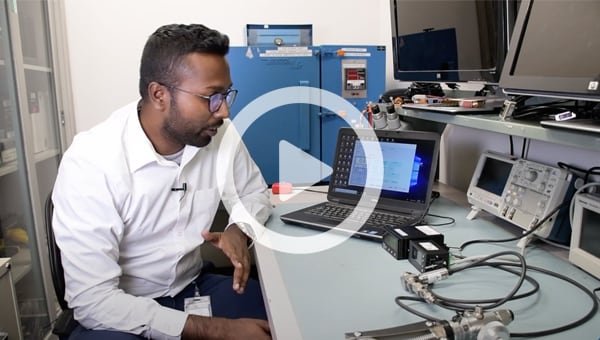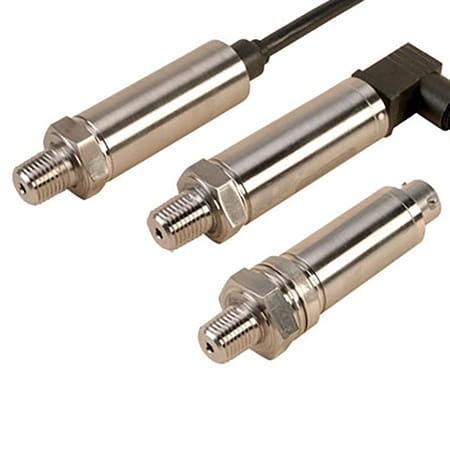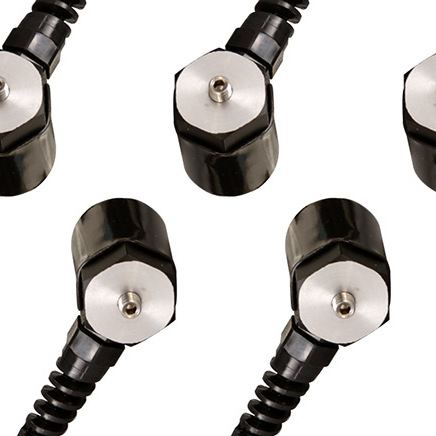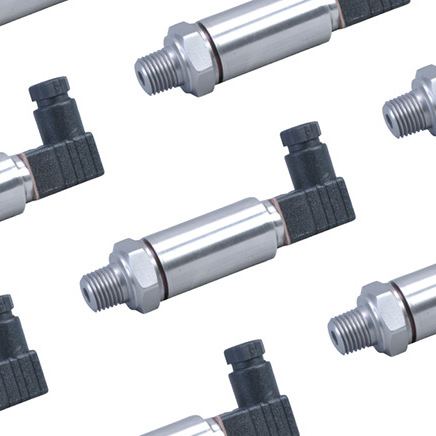OMEGA transducers have three main types of electrical outputs; millivolts (mV), volts (V), and current (mA). It is important for the user to know which output suits his application to ensure proper selection of a transducer.
The following will describe the advantages, disadvantages, and wiring for millivolt, volt and current output transducers.
TRANSDUCER OUTPUTS AND THEIR WIRING CONFIGURATIONS
Transducers with a millivolt output are generally used in laboratory applications. They are low cost, small in size, and require a regulated power supply. Remembering that the millivolt signal is very low level, it is limited to short distances (up to 200 feet is usually considered the limit) and is very prone to stray electrical interference from other nearby electrical signals (other instrumentation, high ac voltage lines, etc.). Typical wiring configurations are shown in Figure 1.
 Figure 1
Figure 1
Transducers with an amplified voltage output are generally used in a light industrial environment and computer interface systems, where a higher level dc signal is required. Due to the built-in signal conditioning, they are higher cost and larger in size than the millivolt output transducers. Amplified voltage signals can travel up to medium distances and are much better in their immunity to stray electrical interference than the millivolt signal. Typical wiring configurations are shown in Figure 2.
A transducer produces millivolts, amplified voltage, or current output. A transmitter produces current output only. Again, due to the built-in signal conditioning, the transmitters are higher cost and larger in size than the millivolt output transducers. Unlike the millivolt and voltage output transducers, a current signal is immune to any stray electrical interference, a valuable asset in the factory. A current signal also can be transmitted long distances. Typical wiring configurations are shown in Figure 3.
HANDLING, LOCATING AND INSTALLING TRANSDUCERS
 Figure 2
Figure 2
- A. Diaphragm - Do not press or touch the diaphragm as you may damage or alter its calibration, particularly on low pressure range models.
- B. Fittings and Hardware - Use appropriate pressure rated fittings and hardware. Make sure you have the correct thread type and size fitting. Use pressure limiters, capacity chambers, snubbers, etc., if needed.
- C. Operate at Ambient Temperatures- Locate the transducer where it can be readily inspected and serviced. Ambient temperature should be within the transducer specifications. The temperature coefficient effects on the overall accuracy of the transducer can be minimized the closer the ambient temperature is to 25°C. Avoid locations with excessive vibration.
- D. Installation - Installation should be made only by qualified personnel familiar with safety practices and knowledgeable with all industry accepted standard relating to pressure systems.Transducer calibration and/or zero may shift if it is over-torqued when installing. Check for a zero shift after installing. When installing transducers, refer to standard industry torque data for thread size and material type.
 Figure 3
Figure 3
DETERMINING HOW MANY TRANSDUCERS CAN BE EXCITED FROM ONE POWER SUPPLY
Multiple transducers can be excited from one power supply. The number of transducers that can be used is simply determined by the current draw of each transducer and the current capacity of the supply source. The sum of the current draw of the transducers can not exceed the total current capacity of the supply. For example, if you have 50 transducers drawing 13 milliamps, you will need a power supply having at least 650 milliamps (50 x 13). There is also nothing wrong with powering just one transducer with a power supply having high current capacity.
Figure 6. Multiple transducers wired to one meter and one switch (transducers with built-in zero & span adjustments, same outputs & same pressure ranges)
Figure 7. Converting current into voltage for instrumentation set up for voltage
WIRING ONE TRANSDUCER TO MULTIPLE READOUTS, RECORDERS, COMPUTERS, ETC.
Pressure transducers that output milliamp signals can connect to multiple devices in series. The fact that they can transmit signals over long distances without interference makes it easier to connect a milliamp-signal device to multiple instrumentation units. This diagram illustrates the correct wiring. One of the great advantages of a current signal is the simplicity in setting up a multi-instrument system. Long distance transmission from instrument to instrument without electrical interference make multi-instrument systems easy. For example, a material test center may have one control room for all the different test labs, enabling operation from one central location. Instrument calibration and troubleshooting are simple in a multi-instrument current loop. The only limitation for the number of instruments is the amount of voltage from the power supply driving the current loop. The minimum voltage required is determined by Ohms law, V-IR (voltage equals current times resistance). This is shown and explained in Figure 4.
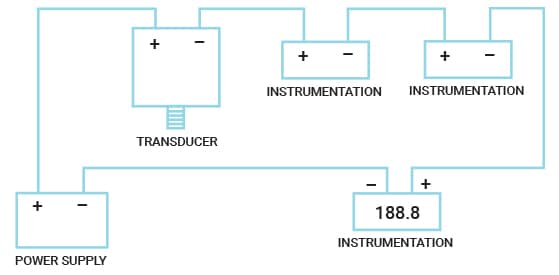 Figure 4
Figure 4
WHERE:
RLINE = resistance due to wire
RLOAD = combined instrumentation resistances
VsTRANSDUCER = minimum supply voltage for transducer
For example, let's assume you have the following:
- Pressure transmitter (4-20 mA) with 12-30 Vdc supply voltage;
- Panel meter with a 10 ohm input impedance;
- Recorder with a 25 ohm input impedance;
- Computer with a 200 ohm input impedance;
- Lead wire resistance of 5 ohms.
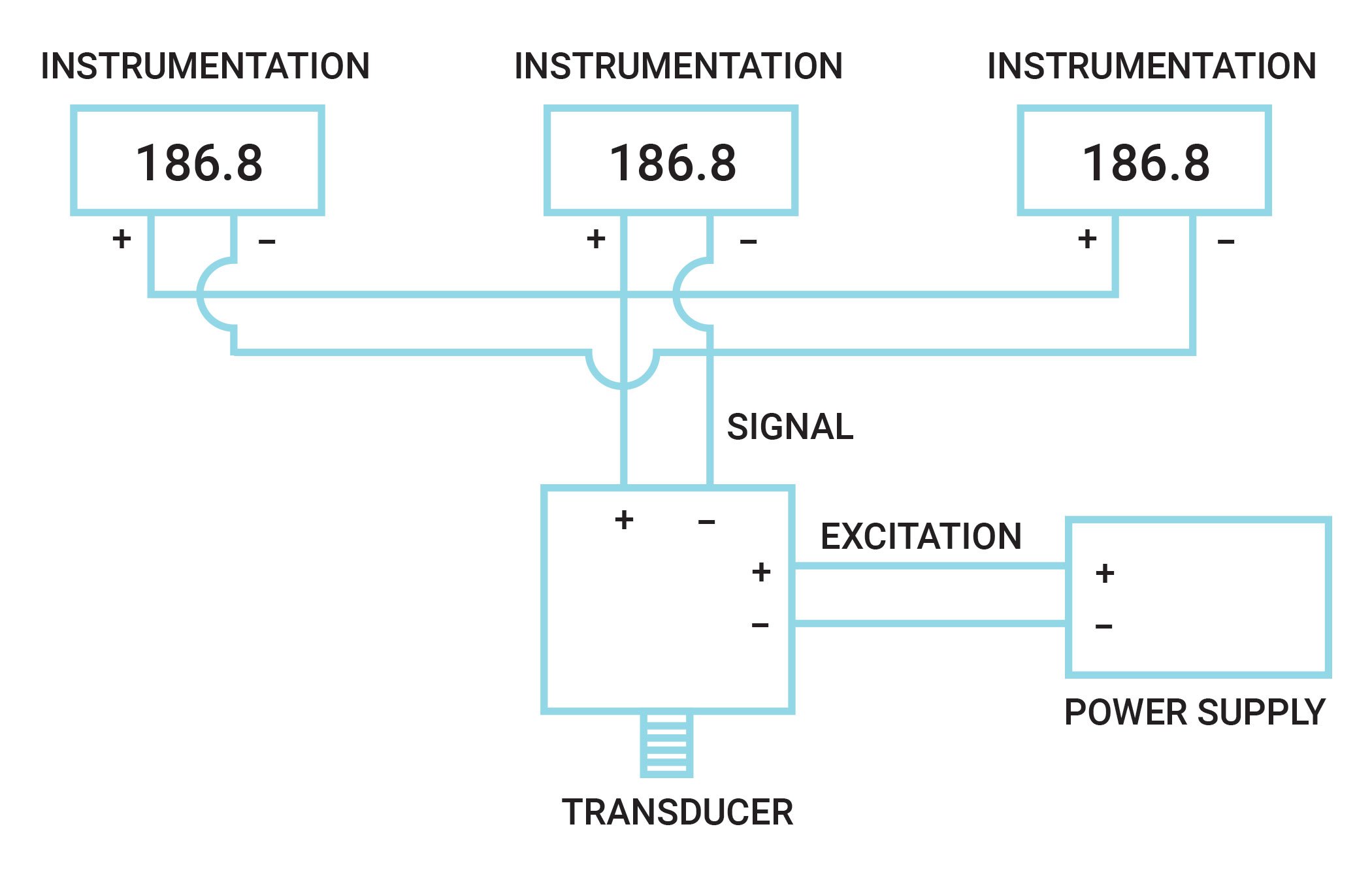 Figure 5
Figure 5
Minimum voltage required = (.020). (5 + 10 + 25 + 200) + 12 = 16.8 volts 24 volts is the most common power supply in a 4-20 mA current loop. Wiring a voltage or millivolt signal to multiple instruments also can be done, but is not as easy and does not have the calibration and troubleshooting advantages inherent in a current loop system. The voltage or millivolt signal can be wired in parallel to multiple instruments as shown in Figure 5. This method assumes a very high input impedance in the instruments being wired. If this is not the case, an analog output can be used instead to retransmit the signal.
Practical example
if you are connecting the PX409 milliamp output pressure transducer to the DP400TP fast-response process meter, you’d wire all instrumentation in series. In this case, the DP400TP can also serve as a power supply, providing the 12 V or additional 20 V DC needed to drive the PX409 unit.Testing the system The PX409 device can be programmed wirelessly using a near-field communication (NFC) device such as a cellphone. The PX409’s signal can then be fed to a PLATINUM series meter, which is another type of fast-response meter. All PLATINUM meters include USB outputs so that they can directly connect to a computer.
Once you’ve installed the system, you can test to ensure it works. To test, follow these three steps:
- Apply pressure to the transducer using a handheld pump.
- Watch to ensure the pressure changs on all three units.
- Verify, once the pressure is steady and static, that all three units are displaying the same pressure readout.
WIRING MULTIPLE TRANSDUCERS TO ONE READOUT, RECORDER, COMPUTER, ETC.
In measuring multiple pressures, it is a common mistake trying to use multiple transducers, a switching device, and just one panel meter, thus saving money on multiple panel meters (or any other instrumentation). The problem is that each transducer has a unique zero point and the readout only has one zero screw. The net result is that the total accuracy increases to about 3%, even though each pressure sensor is 0.5% accurate. In most cases, this larger error is intolerable.
The correct method of using multiple transducers with one readout device is to use transducers that have built-in zero and span adjustments screws, the same output (voltage or current), and the same pressure range. Each transducer is adjusted by applying a known pressure, so that they all have identical outputs. When they all have identical outputs, the meter is scaled and a switch can be used.
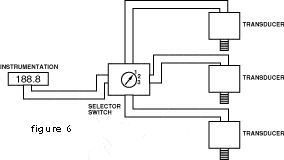 Figure 6
Another solution to using multiple transducers with one readout is to use a scanner instead of meter and a switch. There are many types of scanners. The type of scanner that works with multiple pressure transducers must have independent scaling on each channel.
Figure 6
Another solution to using multiple transducers with one readout is to use a scanner instead of meter and a switch. There are many types of scanners. The type of scanner that works with multiple pressure transducers must have independent scaling on each channel.
Some scanners, besides having independent scaling on each channel, also offer independent current, voltage, or millivolt inputs to each channel. These types of scanners enable you to use transducers with different outputs as well as different pressure ranges with the same instrument.
Figure 2. Typical wiring configuration for voltage output transducer (-excitation and -signal are common)
Figure 1. Typical wiring configuration for millivolt output transducer
Figure 3. Typical wiring configuration for current output transducer
Figure 4. Multi-instrument 4-20mA current loop (panel meters, chart recorder, computers, etc.)
Minimum voltage req'd = (0.20 Amps)(R LINE + R LOAD) + Vs TRANSDUCER
Figure 5. Multiple instruments wired in parallel to a voltage output transducer
USING A MILLIAMP SIGNAL WITH VOLTAGE INPUT INSTRUMENTATION
Most instrumentation is set up to receive voltage. A commonly asked question is how to use a current signal with instrumentation set up for voltage. This is simply done by installing a resistor across the input terminals of the instrumentation. The value of the resistor is determined by Ohms law (V = IR). For example, installing a 500 ohm resistor will convert 20 mA to 10 volts (V = IR = .020 x 500). This is shown in Figure 7. The only other consideration is the zero offset. Since most current loops have a low end of 4 mA, there will be a zero offset. Using the same value resistor as above 4 mA will convert to 2 volts.
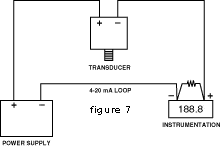 Figure 7
R=V/I
Figure 7
R=V/I
Where:
R = Size of Resistor
V = Desired Voltage
I = Current
Example:
To Convert 4-20 mA into 2-10 V
R = V/I = 10/.02 = 500 Ohms A 500 Ohm Resistor Would be Installed Across the (+) and (-) Terminals on the Instrumentation
Pressure transducer pipe installation
Pressure transducer pipe installation requires a professional with hands-on experience in setting up pressure sensors. The reason to choose a professional service is that improper installation can result in fluid leaks that may be hazardous to both man and machine.The method of installation and the positioning of the pressure transducer will depend on the pressure media (liquid, gas or steam) and the orientation of the pipe. The choice between internal or external pressure transducer mounting also depends on the setup.
- What is a pressure transducer?
- How do pressure transducers work?
- Pressure sensor vs transducer
- Custom pressure transducers
- Pressure transducers FAQ
- Selecting a pressure sensor
- How to specify
- Installing a pressure transducer
- Troubleshooting
- Selecing an amplifier
- Selecing a controller
- Selecing a data logger
